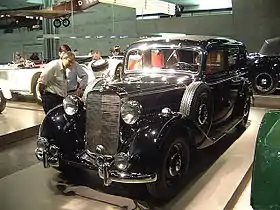Mercedes-Benz 260 D
The Mercedes-Benz 260 D, coded Mercedes-Benz W 138 according to internal works designation, was one of the first three diesel engined series produced passenger cars, together with 1933 Citroën Rosalie 11UD and the diesel version of the Hanomag Rekord. The 260 D was named in reference to its engine's cubic capacity. Nearly 2,000 vehicles were assembled until 1940, after which the Daimler-Benz group had to devote itself almost entirely to military manufacture.
| Mercedes-Benz 260 D (W138) | |
|---|---|
 | |
| Overview | |
| Manufacturer | Mercedes-Benz |
| Production | 1936–1940 |
| Body and chassis | |
| Class | Full-size sedan |
| Body style | 4-door sedan landaulette cabriolet |
| Layout | FR layout |
| Powertrain | |
| Engine | 2545 cc OM138 I4 diesel |
| Transmission | three-speed gearbox with overdrive (Nullserie), four-speed with synchromesh on all ratios from 1937. |
| Dimensions | |
| Wheelbase | 3,050 mm (120.1 in) |
| Length | 4,390 mm (172.8 in) |
| Width | 1,630 mm (64.2 in) |
| Curb weight | 1,530 kg (3,373 lb) |
Pilot series
First attempts by Daimler-Benz to assemble a 6-cylinder diesel engine in a Mercedes-Benz Mannheim chassis ultimately failed due to its enormous vibration. 1936 saw the successful installation of a smaller 2545 cc overhead valve, 4-cylinder engine in a Mercedes-Benz 230 (W21) chassis. It employed the Bosch diesel fuel injection system and produced 45 bhp (34 kW) at 3000 rpm. The car weighed approximately 1,530 kg (3,373 lb) and could attain a top speed of 95 km/h (59 mph).
170 pullman-landaulets based on the W21 chassis were built from 1936 to 1937, called the Nullserie and used only as taxis, with a three-speed plus overdrive transmission, without syncromesh on the first gear.
1937–1940
The second series was manufactured, from 1937 on, the regular production of the 260D based on the Mercedes-Benz W143, with a four-speed fully synchronized transmission. The chassis was based on contemporary Mercedes technology and had transverse leaf spring independent front suspension and swing axles at the rear. The brakes were hydraulic. A range of body types were made including saloons, landaulettes and cabriolets. After World War II, the production of diesel engined cars was resumed with the Mercedes-Benz 170D in 1949.
A surviving example of the car is displayed at the Mercedes-Benz Museum in Stuttgart, Germany.
Also another model is owned by Mr. Hormusji Cama, Owner of Bombay Samachar newspaper